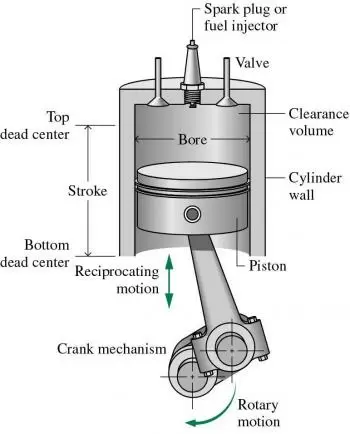
Diesel engines are also known as compression ignition engines. The diesel engine is a type of internal combustion engine that uses the diesel thermodynamic cycle.
The real efficiency of diesel cycle heat engines is between 35% and 40% and it is widely used to power vehicles.
In this type of engine, combustion is carried out at constant pressure, according to the cycle that has taken the name of its inventor. Compared to gasoline engines they have a better compression ratio which makes them more efficient.
In this type of engine, combustion takes place at constant pressure, according to the diesel cycle.
The compression ignition engine is based on the work of Rudolf Diesel, who made his first engines around 1892.
At the time of designing the diesel engine, Rudolf Diesel was looking for an alternative to the steam engines of the time. The goal was to design an engine with higher thermal performance, lower weight and lower cost.
How does a diesel engine work?
A diesel engine works by injecting pulverized fuel into the combustion chamber. The injection is carried out at a time when the pressure and temperature inside is very high, which causes it to ignite.
The real cycle of a diesel engine follows with a reasonable approximation the theoretical cycle composed of the evolutions:
-
Isentropic compression
-
Part of heat input at constant volume (isochoric process) and part of heat input at constant pressure (isobaric process)
-
Isentropic expansion
-
Constant volume heat rejection (isochoric process)
This cycle, as described, is called a mixed cycle. When all the energy is introduced at constant pressure, the cycle is called the diesel cycle.
The cycle begins with the top dead center (TDC) plunger. The intake valve is open and the plunger as it descends, the cylinder is filled with air by aspiration.
The plunger reaches bottom dead center (PMI) and then compression begins. The temperature of the air inside the cylinder rises substantially, which is critical for starting a diesel engine.
Shortly before TDC, the fuel begins to be injected into fine droplets in order to evaporate easily and, when it comes into contact with the hot air, it ends up self-igniting, pushing the piston downward. Combustion is controlled by the fuel injection rate.
Expansion begins even during the combustion phase which, unlike the gasoline engine, is an adiabatic process. The expansion generates a rectilinear downward movement of the piston. The piston is connected to the crankshaft through the connecting rod, which is what transforms rectilinear motion into rotary motion. Before the expansion time expires, the exhaust valves open.
The cycle ends with the exhaust phase, in which the combustion gases are expelled from the cylinder.
Diesel engines can operate with 4-stroke and 2-stroke cycles.
What fuel does a diesel engine use?
The fuels used are liquid petroleum derivatives with lower characteristics than the fuel used in spark ignition engines (caused by a spark plug). The specific gravity of these fuels is higher. The most notable type of fuel used for automobile engines is diesel.
In addition to diesel, you can also use fuel oil, treated oils (such as biodiesel or other biofuels) or coal dust. In general, they are fuels that ignite spontaneously when subjected to high pressure.
Fuel is fed exclusively by injection.



